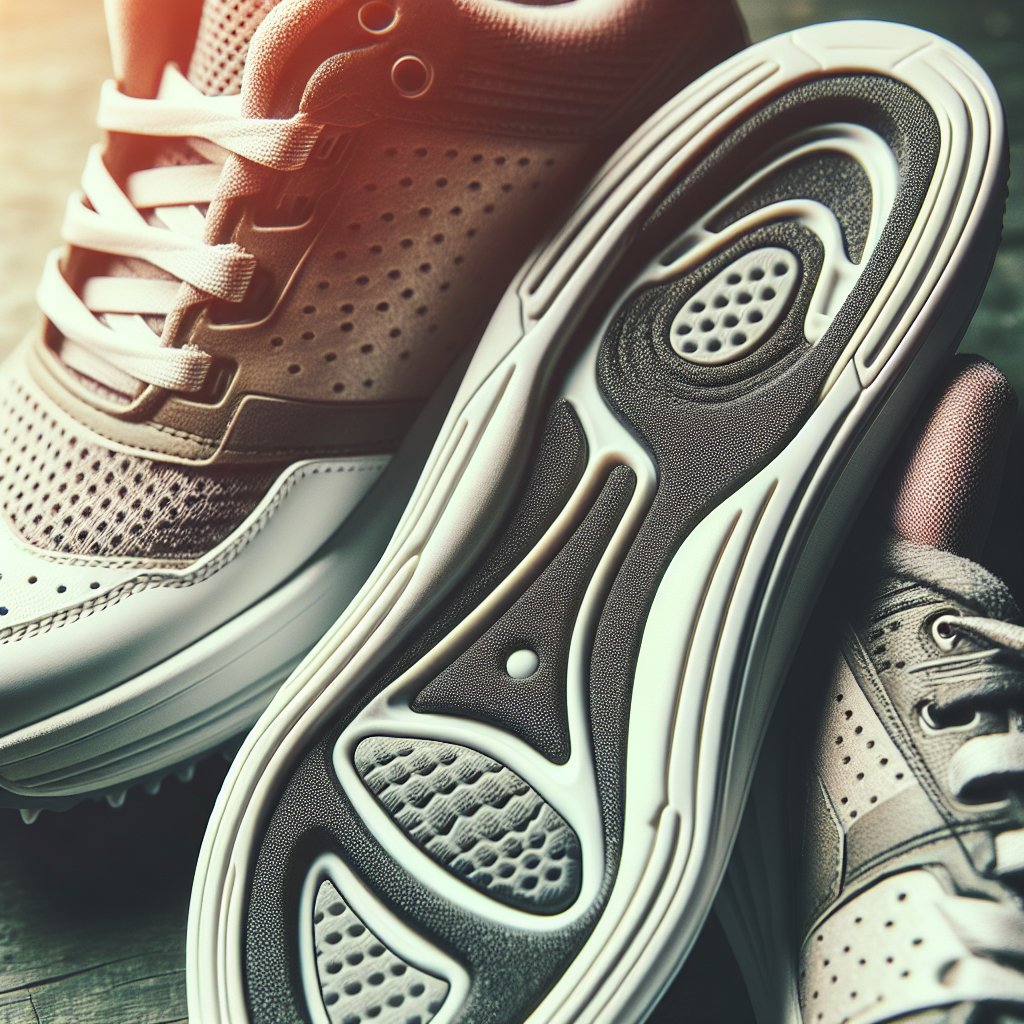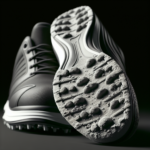
Have you ever wondered about the role that insoles play in golf shoes? It turns out they are more important than you might think. Not only do insoles provide comfort and support, but they can also help improve your balance and stability during your swing. But what happens when your insoles wear out or become uncomfortable? Can they be easily replaced? In this article, we’ll explore the importance of insoles in golf shoes and answer all your questions. So, let’s get started!
The Structure of Golf Shoes and the Role of Insoles
The Design and Construction of Golf Shoes
Golf shoes are specially designed to provide stability and traction on the golf course. They typically feature a sturdy upper made from materials like leather or synthetic materials to offer support and durability. The outsole is equipped with spikes or nubs to improve traction, especially in wet conditions. Additionally, golf shoes often have a midsole that provides cushioning and shock absorption.
The Purpose of Insoles in Golf Shoes
Insoles are an integral component of golf shoes as they add an extra layer of cushioning, support, and comfort. They are placed inside the shoe, directly under the foot, and play a crucial role in enhancing both fit and performance. Insoles help to distribute impact forces more evenly and reduce the strain on the feet, knees, and lower back.
How Insoles Provide Cushioning and Support
Insoles are designed to provide cushioning and support by absorbing the shock generated during the golf swing. They are usually made from materials like foam, gel, or a combination of both. These materials have the ability to compress and release energy, effectively minimizing the impact on the feet and joints. Insoles also provide arch support, helping to maintain the natural alignment of the foot and improve overall stability.
The Importance of Proper Fit in Golf Shoes
The Connection between Fit and Performance in Golf
Proper fit is paramount when it comes to golf shoes as it directly affects performance. Ill-fitting shoes can cause discomfort, hinder movement, and even lead to injuries. A well-fitting pair of golf shoes provides stability, mobility, and allows the golfer to have better control over their swings. It is crucial to ensure that your golf shoes fit properly before hitting the course.
The Impact of Ill-Fitting Golf Shoes on Swing Mechanics
If your golf shoes are too tight or too loose, it can negatively impact your swing mechanics. Tight shoes can restrict the natural movement of the foot and cause discomfort, leading to a compromised swing. On the other hand, loose shoes can result in instability and loss of balance during the swing. Both scenarios can affect your ability to generate power and accuracy in your shots.
The Role of Insoles in Enhancing Fit and Comfort
Insoles can greatly enhance the fit and comfort of your golf shoes. They provide additional cushioning, support, and help fill any gaps or spaces between the foot and the shoe. Insoles can be used to customize the fit of your shoes, especially if you have specific foot conditions or require extra support in certain areas. They help create a snug fit that reduces slippage and improves overall comfort.
The Benefits of Insoles in Golf Shoes
Improved Shock Absorption and Reduction of Impact Forces
One of the key benefits of using insoles in golf shoes is improved shock absorption. The repetitive nature of the golf swing can generate significant impact forces that can put strain on the feet and joints. Insoles with cushioning properties help absorb these forces, reducing the risk of discomfort and potential injuries.
Enhanced Stability and Balance
Insoles provide stability and balance by offering additional support to the arches of the feet. This added support helps prevent the foot from rolling inward or outward during the swing, ensuring a more stable and balanced position. By maintaining proper alignment, golfers can achieve a more consistent swing and transfer of power.
Increased Comfort and Reduced Fatigue
Golf rounds can be quite lengthy, and spending hours on the course can take a toll on your feet. Insoles are designed to enhance comfort by reducing pressure points, providing cushioning, and minimizing fatigue. By keeping your feet comfortable and supported throughout the round, you can focus more on your game and prevent unnecessary distractions.
Types of Insoles for Golf Shoes
Off-The-Shelf vs. Customized Insoles
When it comes to insoles, golfers have the option of choosing off-the-shelf or customized ones. Off-the-shelf insoles are readily available at sporting goods stores and are designed to fit a wide range of foot sizes and shapes. Customized insoles, on the other hand, are tailored specifically to an individual’s foot measurements and specific needs. While off-the-shelf insoles can provide general support and comfort, custom insoles offer a more personalized fit and targeted support.
Different Materials Used in Insoles
Insoles can be made from various materials, each offering different benefits. Foam insoles provide lightweight cushioning and are often used for shock absorption. Gel insoles offer a more responsive cushioning experience and can provide additional support. Some insoles combine both foam and gel materials to provide a balance of cushioning and support. It’s important to choose the material that suits your preferences and foot condition the best.
Features to Look for in Golf Shoe Insoles
When selecting insoles for your golf shoes, there are certain features to consider. Look for insoles with good arch support, as this helps maintain proper alignment and prevent overpronation or supination. Cushioning is also important, especially in the heel and ball of the foot, as these areas bear the most pressure during the golf swing. Additionally, moisture-wicking properties can keep your feet dry and comfortable throughout the round.
Replacing Insoles: When and How
Signs that Insoles Need to be Replaced
Insoles, like any other component of your golf shoes, will eventually wear out and lose their effectiveness. Signs that your insoles need replacement include visible wear and tear, flattened cushioning, decreased support, and a loss of overall comfort. If you notice any of these signs or feel discomfort during your rounds, it may be time to replace the insoles.
How to Properly Replace Insoles in Golf Shoes
Replacing insoles is a simple process that can be done at home. Start by removing the old insoles from your golf shoes. Clean the shoe’s interior if necessary. Next, align the new insoles with the shoe’s contours and make any necessary adjustments to ensure a proper fit. Finally, insert the new insoles inside the shoes, making sure they lie flat and are positioned correctly.
Frequency of Insole Replacement
The frequency of insole replacement depends on various factors, including the frequency of use, the intensity of play, and the quality of the insoles. As a general rule of thumb, it is recommended to replace the insoles every 6 to 12 months or when signs of wear and decreased performance start to show. Regularly inspecting and evaluating the condition of your insoles will help determine when they need to be replaced.
How to Choose the Right Insoles for Golf Shoes
Considerations for Selecting Insoles
When choosing insoles for your golf shoes, consider your specific needs and foot condition. Are you looking for additional cushioning, arch support, or a combination of both? Take into account your playing style, the type of golf course you frequent, and the amount of time you spend on your feet during rounds. It’s important to find insoles that are compatible with your existing shoes and offer the desired level of support and comfort.
Assessing Foot Type and Specific Needs
Understanding your foot type is crucial in selecting the right insoles. Individuals with high arches may require insoles with more pronounced arch support to prevent excessive pronation. Golfers with flat feet may benefit from insoles that provide added cushioning and stability. Consulting with a podiatrist or footwear specialist can help determine your specific foot type and any conditions that need to be addressed.
Seeking Professional Advice
If you are unsure about which insoles to choose or have specific foot conditions, it is recommended to seek professional advice. Podiatrists, orthopedic specialists, or experienced footwear professionals can provide expert guidance in selecting the right insoles for your golf shoes. They can assess your foot mechanics and offer personalized recommendations to address any specific needs or conditions.
Insoles and Common Foot Conditions in Golfers
Plantar Fasciitis and the Role of Insoles
Plantar fasciitis is a common foot condition that causes heel pain and discomfort. Insoles can play a significant role in managing plantar fasciitis by providing additional arch support and cushioning. Insoles with heel cups and shock-absorbing properties can help alleviate pain and reduce strain on the plantar fascia. The use of insoles, combined with proper stretching and strengthening exercises, can aid in the treatment and prevention of plantar fasciitis in golfers.
Metatarsalgia and Insole Support
Metatarsalgia is characterized by pain and inflammation in the ball of the foot. Insoles with metatarsal support can help alleviate the pressure and redistribute the weight on the forefoot, reducing the discomfort associated with metatarsalgia. These insoles often have a cushioned pad or arch support that lifts and supports the metatarsal heads, providing relief during the golf swing.
Preventing and Alleviating Foot Pain with Insoles
Other common foot conditions in golfers, such as heel spurs, achilles tendonitis, and shin splints, can also be managed or alleviated with the use of insoles. Insoles that offer targeted support and cushioning in specific areas can help reduce the strain on these vulnerable areas and minimize pain and discomfort. It’s essential to consult with a healthcare professional to determine the best course of action for your specific foot condition.
Maintaining and Cleaning Insoles
Proper Care and Cleaning of Insoles
To maximize the lifespan of your insoles, it is important to practice proper care and cleaning. Remove the insoles from your golf shoes and gently wash them with mild soap and warm water. Avoid using harsh chemicals or excessive rubbing, as they may damage the insoles. After cleaning, rinse thoroughly and allow the insoles to air dry completely before placing them back into the shoes.
Tips to Prolong the Lifespan of Insoles
In addition to regular cleaning, there are several tips to help prolong the lifespan of your insoles. Avoid exposing them to extreme heat or direct sunlight, as this can cause material deterioration. When not in use, store your golf shoes in a cool and dry place to prevent the insoles from becoming damp or moldy. Rotation between multiple pairs of insoles can also help distribute wear evenly, increasing their durability.
Replacing Insoles vs. Cleaning Them
While regular cleaning can help maintain the hygiene and freshness of insoles, there will come a time when replacement becomes necessary. Cleaning can only do so much to extend the lifespan of insoles, and eventually, their cushioning and support properties will diminish over time. When you notice signs of wear and decreased performance, it’s advisable to replace your insoles to ensure optimal foot comfort and support.
Insoles and Shoe Fit Adjustments for Different Types of Golfers
Insoles for High-Arched Golfers
High-arched golfers often require insoles with added arch support to minimize excessive pronation and provide stability. Insoles with a rigid arch support structure can help maintain the natural alignment of the foot and prevent the arches from collapsing. These insoles can also distribute the weight more evenly, reducing pressure on specific areas of the foot and enhancing comfort.
Insoles for Flat-Footed Golfers
Flat-footed golfers can benefit from insoles that offer additional cushioning and support. Insoles with a contoured footbed and arch reinforcement can help provide the necessary stability and shock absorption for flat feet. The cushioned padding can help alleviate discomfort and reduce the strain on the feet, allowing for a more comfortable and enjoyable golfing experience.
Insoles for Golfers with Pronation Issues
Golfers with overpronation (inward rolling of the foot) or underpronation (outward rolling of the foot) may require insoles that address their specific gait mechanics. Insoles with motion control features can help correct pronation issues by providing support and stability to the foot. These insoles often have a reinforced arch and heel cup to control excessive movement and promote a more efficient golf swing.
The Importance of Insoles in Golf Shoe Performance
The Link between Foot Comfort and Performance in Golf
Foot comfort plays a vital role in golf shoe performance. When your feet are comfortable, you are less likely to be distracted or inhibited by foot pain or discomfort during your swing. Insoles contribute significantly to foot comfort by providing cushioning, support, and stability. By enhancing the overall comfort of your golf shoes, insoles can positively impact your performance on the course.
How Insoles Boost Stability and Prevent Injuries
Stability is crucial in golf, as it allows for consistent swings and accurate shots. Insoles with proper arch support and shock-absorbing properties help maintain stability by reducing excessive foot movement and minimizing the risk of injuries. The added support and cushioning provided by insoles help stabilize the foot during the swing, preventing potential strains or sprains.
Enhancing Golf Shoe Versatility with Insoles
Insoles can enhance the versatility of golf shoes by allowing for customization and adaptability. They provide the flexibility to adjust the fit, support, and cushioning to suit individual preferences and specific foot conditions. Whether you need extra support on certain areas of the foot or require more cushioning for added comfort, insoles can help transform your golf shoes into a personalized and performance-enhancing piece of equipment.
In conclusion, insoles play a significant role in golf shoes by providing cushioning, support, and comfort. They enhance the fit, stability, and balance of golf shoes, contributing to improved performance on the course. Whether addressing common foot conditions, customizing the fit, or prolonging the lifespan of your golf shoes, insoles are a valuable addition to any golfer’s footwear. By choosing the right insoles and properly maintaining them, you can enjoy a more comfortable and enjoyable golfing experience.





